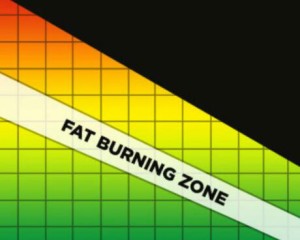What You Need to Know About the Fat Burning Zone
Ever wondered what the Fat Burning Zone really is?
You may have seen this Heart Rate Graph above while training on the treadmill or stationary bike at the gym.
You may have even asked yourself, “is there really a ‘magical’ heart rate zone where you burn fat?”
Is that how the body really works?
Here’s a few things you should know about the ‘fat burning zone’ that will help you answer that questions.
1. The fat burning zone burns a higher percentage of calories from fat but…
When you work out in the ‘fat burning zone’, 45-65% of you max heart rate, you do tend to use more fat for fuel but you’re burning less calories overall.
Weight loss (or fat loss) comes down to burning more calories than you consume (eat).
It doesn’t matter if you’re burning those calories from fat, protein or carbs.
So if you can burn more calories per minute by exercising at a higher heart rate, would it make more sense to work out in a higher training zone instead?
In general, the answer is yes. At higher heart rates you burn more calories (and more fat) increasing the rate at which you lose weight.
2. The more efficient you are the less calories you burn.
Fat burning zone training is often times called long endurance training because it allows you to train for longer periods of time.
So you’re preparing for a marathon, running many miles per week, you’re going to start to improve your running technique and the body will start to adapt to the demands of the training.
This adaptation allows you to be more efficient and perform better, exactly what you want with performance related goals.
But if you have fat loss or weight loss goals, you don’t want to become more efficient because you’ll end up burning less calories per workout.
Now you’re going to have to run longer (or faster) to burn the same amount of calories. It’s far more likely that you’re going to get efficient when training in the fat burning zone.
3. Long endurance training can compromise muscle and lower your metabolic rate.
Doing long endurance ‘fat burning zone’ training doesn’t stimulate muscle growth.
In fact, it can make your muscles smaller slowing down your metabolism.
How important is muscle mass to your fat loss efforts?
It’s everything!
Your metabolic rate hinges upon how much lean muscle you have and how often you are training those muscles.
That’s because your body uses a tremendous amount of energy (calories) to build and maintain your muscle tissue even while you sleep.
At this point you’re probably thinking the ‘fat burning zone’ has no place in your or anyone’s training program.
But it does.
Like any tool, it just needs to be applied correctly.
Here’s how you do it.
1. Take short walks of 30-60 min on daily basis. This can improve your health and overall well being. First thing in the morning is recommended.
2. Once a week, go out for a long hike, jog or bike ride. It’s really important to train the body to exercise for hours at a time because along with improving health, increasing work capacity is something we all should strive for.
3. If you’re preparing for a an aesthetic event (fitness or body-building) or have severely restricted your calorie intake then this may be the only zone you can effectively work out in.
4. If you’re just starting out with an exercise program the fat burning zone is a great place to build up your cardiovascular foundation.
5. After training at high intensities for long periods of time we all need light days to rest and recover. See number 1.
If you follow these recommendations you can use the fat burning zone to get the specific results you want and keep your muscle and metabolic rate at the same time.
If you have any questions on heart rate or endurance training please feel free to contact me at 719-640-0141 or email me at info@precisionfitnesstrainer.com.
Move Better, Live Well
Edward Scaduto



